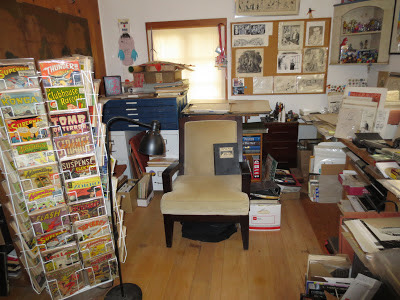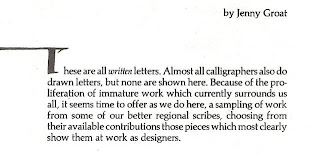I’ve always been fond of scratchboard. Scratchboard is a heavy paper stock with an inked, chalky coating which can be scratch to reveal the white below.
A full description of scratchboard technique from Henry C. Pitz’s classic 1949 text, Pen Brush and Ink, is presented below.
(don't forget to click on images to enlarge)
Scratchboard was a flexible, versatile material as evidenced by how often it was employed historically by illustrators and cartoonists. I say “was” because although a few artists may still use it, scratchboard-- like most other handmade graphic art materials in this digital age-- is probably doing a slow fade
Below are a few examples from my Vault of original art done on scratchboard.
This piece was done by Rowel Friers, the brilliant Irish cartoonist and illustrator, for the Dublin Opinion in 1949.
Ervine Metzl did this illustration for the New Yorker .
A nice piece by cartoonist Bill Hoest (circa 1960's).
A beautifully rendered frog by Marin county artist Kathleen Edwards.
Another piece by Kathleen Edwards (this is from Molly’s collection).
Dalison gave me this nice practice piece back in the early 1980’s.
A simple but effective use of scratchboard by an artist named Thorne (I don’t know his first name). It appeared in Galaxy magazine in 1951 as an illustration for a story by Damon Knight.
A dramatic illustration for the science fiction magazine Worlds of Tomorrow 1966 by Peter Lutjens.
John Adkins Richardson goes to town on the this piece used as the cover of Fantastic Exploits in 1969.
John Bunch combines scratchboard with a nice gray opaque tones for this illustration of Isaac Asimov’s short story "Tyrann", again for Galaxy magazine (1951).
As I stated I’ve always liked the scratchboard technique.
In fact, one of the very first drawings I ever sold (as a teenager) was a scratchboard spot drawing to Writers Digest magazine.
Here are some scratchboard odds and ends by me from years gone by….
Skeleton a little practice piece from long ago.
This tiny little alien was done in 1974.
More outer space stuff (1975).
Another exercise
Ditto
The cover of my mini book No Audience (1981)
A panel from the comic book story"A Lil' Monster Making a Phone Call"
(it appeared in Eclipse magazine 1982)
The back cover of one of my New Years cards (circa 1981)
Rippee images copyright 2013 Rippee



























.jpg)




